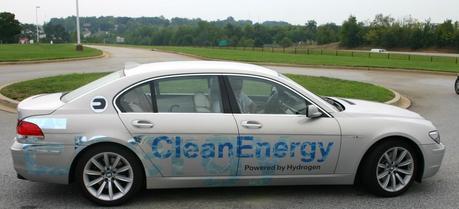 BMW Hydrogen 7. (Credit: Flickr @ Adam Gautsch https://www.flickr.com/photos/gautsch/)
BMW Hydrogen 7. (Credit: Flickr @ Adam Gautsch https://www.flickr.com/photos/gautsch/)Researchers at Lawrence Livermore National Laboratory (LLNL) plan to use nanoparticles to increase the onboard storage capacity of hydrogen-powered vehicles.
Using $1.2 million from the Department of Energy’s Office of Energy Efficiency and Renewable Energy (EERE) over three years, LLNL scientist Brandon Wood said that through theory and modeling, his team will tackle the existing kinetic limitations when it comes to making the most efficient nanoparticles for onboard hydrogen storage.
SEE ALSO: GM, Honda to Develop Next-Gen Fuel Cells Together
The project begins in July and involves additional participation from the University of Michigan and Georgia Tech, as well as experimental support from Sandia National Laboratories.
Wood and colleague Tae Wook Heo will use multiscale modeling to investigate the kinetics of a high-capacity hydrogen-storage candidate based on nanoparticles of magnesium borohydride for light-duty vehicles. The modeling framework, originally developed by Heo and Wood, was created using Laboratory Directed Research and Development funds.
“This approach will substantially accelerate the development of borohydride-based hydrogen storage materials by providing the necessary understanding of the underlying kinetic limitations and how to overcome them,” Wood said. “It will lay the foundation for meeting ultimate light-duty vehicles.”
Ideally, the new material would be able to readily absorb and release hydrogen in a vehicle, while significantly reducing the volume of the gas that needs to be pumped into the tank. “It’s like a sponge that absorbs hydrogen in a solid matrix, giving it a much higher density for storage,” Wood said.
Unlike conventional hydrogen storage tanks, the new tank would be much smaller and would not require the hydrogen to be stored at cryogenic temperatures.
Magnesium borohydride nanoparticles have a high hydrogen storage capacity as well as demonstrated reversibility, so they are excellent candidates for onboard hydrogen storage, Wood said.

Lawrence Livermore researcher Brandon Wood. (Сredit: LLNL)
However, they experience very poor reaction kinetics, which limits hydrogen uptake and release to excessive temperatures and pressures that are impractical in a vehicle. If a viable strategy for improving kinetics could be devised and implemented, then the material would have an excellent chance to meet all DOE system targets, Wood said.

